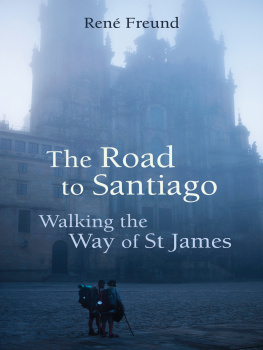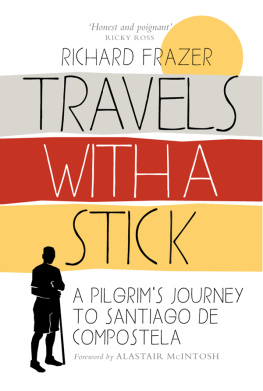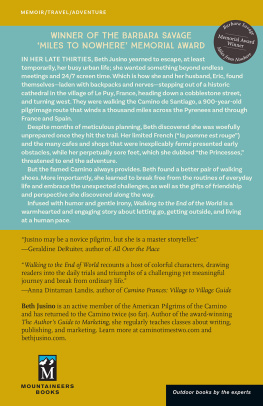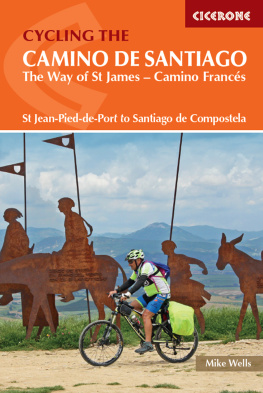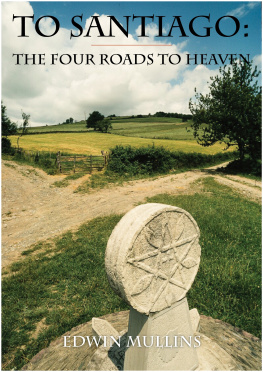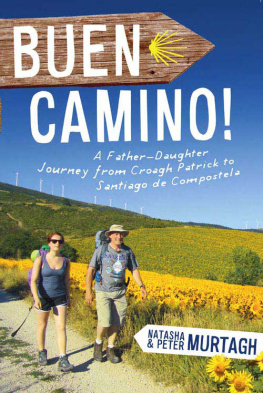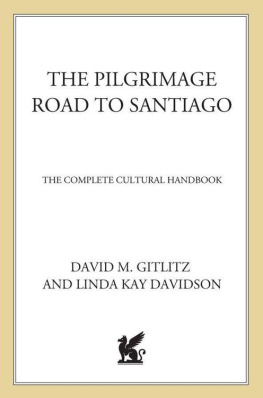The Road to Santiago
First published in English as On Foot to the End of the World in 2006
This paperback edition published in 2016 by
The Armchair Traveller at the bookHaus
70 Cadogan Place, London SWIX 9AH
www.hauspublishing.com
First published in Austria Bis aus Ende der Welt Zu Fu auf dem
Jakobsweg by Picus Verlag in 1999. Copyright 1999 Picus Verlag, Wien.
English language translation copyright 2006 Janina Joffe
The moral rights of the author have been asserted.
A CIP catalogue record for this book is available from the British Library
ISBN: 978-1-909961-22-7
eISBN: 978-1-909961-31-9
Typeset in Garamond MacGuru Ltd
Printed in Spain
CONDITIONS OF SALE
All rights reserved. No part of this publication may be reproduced, stored in a retrieval system, or transmitted in any form or by any means, electronic, mechanical, photocopying, recording or otherwise, without the prior permission of the publisher.
This book is sold subject to the condition that it shall not, by way of trade or otherwise, be lent, re-sold, hired out or otherwise circulated without the publishers prior consent in any form of binding or cover other than that in which it is published and without a similar condition including this condition being imposed on the subsequent purchaser

Spring 1999
There is a finished manuscript lying in front of me. Surrounding me are nearly five kilograms of notes: diary entries, receipts, brochures, shopping lists, packing protocols, letters, statistics, maps
I will now banish all these piles of paper into a box and send the manuscript to the publisher. And then the Way-of-St-James-chapter will finally be closed.
Im trying to document my experience of the journey to Santiago in this book. Im using the word document because it refers to the fact that I have barely changed some of the documents diary entries or letters that I have drawn upon. I have done this because a literary reworking or a stylistic smoothing of these notes would have felt mannered and counterproductive.
I also did away with all too many bits of practical advice to the reader. First of all one can use detailed hiking guides for that purpose and secondly everyone walks the journey with his own two feet and sees it with his own eyes. Consequently, any hints or warnings only have a limited value.
So, now I will send the manuscript to the publisher and with that no, the Way-of-St-James-chapter will not be closed. There is an old pilgrims saying that Ive only just recognised to be true: The journey doesnt end in Santiago. The journey begins in Santiago.
June 1998
How does one come up with the strange idea of walking on foot for two months to a cathedral one never even knew existed? Many pilgrims believe in providence and will simply smile when one tells them of coincidences. Im no great believer in a magical worldview because I believe that we humans create most situations for ourselves, but somehow things did seem a bit jinxed on our journey.
We my wife Barbara and I have always wanted to take a long trip but never quite knew when, how or where to.
At the wedding of two close friends I met a man who spent the evening telling me fascinating stories of his experiences on one of the oldest pilgrim routes in the world: the Way of St James to Santiago de Compostela. I not only found out a lot about the life of a modern pilgrim, but also about the history of the Camino de Santiago, as the Way is referred to in Spanish. It is named after Saint James or James the Great, Sant Iago in Spanish, Saint Jacques in French. James and his brother John belonged to the inner circle of the Apostles. James was one of the first martyrs: he was beheaded around the year 44. Other than these facts, not much of what is known about him is indisputable. It is said that two of Jamess students took his body from Jerusalem to Galicia in western Spain, where the apostle had allegedly evangelised. There, James found his final rest until either the year 813 or 825, no one knows for sure. In that year a pious recluse was led to the grave of the saint by a supernatural light over a field (campus stellae, Starfield). To cut the story short, Santiago de Compostela arose as a result.
It is certainly no coincidence that the Reconquista began parallel to the cultivation of this legend; the Reconquista being the Christian reclaiming of the Islam-ruled Iberian Peninsula. This recapturing took time, from about the 8th to the 15th century. This was partly due to the fact that the population itself was satisfied with the Islamic-Moorish governance Christians and Jews, for example, had complete religious freedom; the economy was flourishing; the first universities were being built on Spanish soil. But then the Christian armies arrived (the first were allegedly led by Charlemagne) and the heydays of poetry, philosophy, science and tolerance ended. The Christians used this opportunity to not only eradicate most of the Moors but also the Jewish population. James was revered as a saint and a great warrior. He is still present in many old Spanish depictions as Santiago Matamaros (moor killer) with a sword, on horseback, surrounded by the severed heads of dark-skinned, frizzy-haired enemies of Christianity.
It didnt take long for Santiago to become as famous a destination for pilgrims as Rome and Jerusalem. In 1078 the construction of a new cathedral began. Old books report a veritable pilgrimage boom between the 12th and the 14th century. Protected by a scallop shell sewn onto ones tippet, one would make a pilgrimage to the apostles grave in order to express gratitude or wishes. There are also reports of pilgrimages ordered by judges as a punishment. Likewise, there were delegated pilgrimages made by professional pilgrims who were paid to travel to Santiago by the individual seeking help.
During the Reformation pilgrimage suffered a crisis. Erasmus of Rotterdam criticised the greed of the apostle (Santiago lived very well from the exploitation of the pilgrims) and Martin Luther ridiculed the followers of the Compostel cult, since one doesnt know whether Saint James or a dead dog or a dead horse lies buried there
The confused stories surrounding Saint James didnt end there, though. In 1879 the apostles grave was rediscovered, so to speak because it had been forgotten where exactly it was. During digs in the cathedral some bones were indeed found: they were certified as undoubtedly those of the apostle by a papal bull. In 1937 General Francisco Franco helped make the apostle cult ultimately dubious by turning St Jamess Day (25 July) into the Spanish national holiday and naming St James the countrys patron saint.
Today, pilgrimage is still extremely popular: In 1982 the Roncesvalles monastery at the beginning of the Camino de Santiago recorded 526 overnighters, in 1997 there were already 11,516. In the holy year 1999 more than twenty million pilgrims were expected in Santiago. (Every year in which St Jamess Day falls onto a Sunday, is considered a holy year and only in these years the puerta del perdon or puerta santa, the eastern portal of the Cathedral of Santiago is opened. St Jamess Festival on 25 July is a great experience for all those who dont suffer from claustrophobia.)
Most of the pilgrims travelling the Camino these days are not walking it for strictly religious reasons. The Camino de Santiago has become a meeting place for all different kinds of people from all over the world, clearly doing justice to its description as Europes first road of culture. Even Goethe suspected that Europe had come into existence through the pilgrimage to Compostela.

